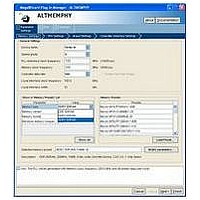IPR-HPMCII Altera, IPR-HPMCII Datasheet - Page 26

IPR-HPMCII
Manufacturer Part Number
IPR-HPMCII
Description
IP CORE Renewal Of IP-HPMCII
Manufacturer
Altera
Datasheet
1.IP-HPMCII.pdf
(176 pages)
Specifications of IPR-HPMCII
Software Application
IP CORE, Memory Controllers, SDRAM
Supported Families
Arria II GX, HardCopy III, Stratix III, Stratix IV
Core Architecture
FPGA
Core Sub-architecture
Arria, HardCopy, Stratix
Rohs Compliant
NA
Lead Free Status / RoHS Status
na
- Current page: 26 of 176
- Download datasheet (4Mb)
2–10
HardCopy Device Migration Guidelines
External Memory Interface Handbook Volume 3
Section II. DDR3 SDRAM Controller with ALTMEMPHY IP User Guide
Enabling Hardcopy Migration Performance Improvement with ALTMEMPHY
In HardCopy III and HardCopy IV designs where higher core performance is
required and I/O performance is not a limiting factor, you can prototype your
HardCopy design in a faster speed grade companion FPGA. However, this practice
introduces some restrictions and limitations. For example, if you target a HardCopy
device with an FPGA device as a prototype, the Quartus II Fitter restricts the VCO
operating range of the PLL to the mid speed grade frequency, regardless of the actual
speed grade of the FPGA that the design is targeting.
You can achieve improved performance when implementing an IP core for use with a
HardCopy device by first generating your IP for a lower-speed FPGA to achieve
optimal implementation, and then compiling your design for the higher-speed FPGA
companion to your HardCopy device. This process is summarized below:
1. Generate your IP core, targeting a mid-speed grade FPGA.
2. Compile your design, targeting a faster speed grade FPGA.
The following sections discuss the above steps in greater detail.
Generating Your IP Core For a Mid-speed Grade FPGA
When you parameterize and generate your controller using the ALTMEMPHY
parameter editor, the PHY, PLL, and DLL are parameterized and generated together
with the controller logic. Robust calibration and operation require that all of these
blocks operate with matched settings. To ensure that you have matched settings, any
IP that includes hard blocks should be generated in the MegaWizard Plug-In Manager
targeting a mid-speed grade FPGA rather than the C2 speed grade. By targeting a
mid-speed grade FPGA, you ensure that any process-dependant settings are
appropriately restricted when the IP core is generated, thereby maintaining a
consistent post-fit implementation throughout the compilation process. You can then
compile the design for either a mid- or high-speed grade FPGA, depending on
whether you want speed enhancements.
The following example illustrates this situation.
Table 2–7. PHY Sequencer Parameters (Part 1 of 2)
DLL_DELAY_BUFFER_MODE
DLL_DELAY_CHAIN_LENGTH
DQS_DELAY_CTL_WIDTH
DQS_OUT_MODE
DQS_PHASE
DQS_PHASE_SETTING
MEM_IF_CLK_PS
MEM_IF_CLK_PS_STR
MEM_IF_MR_0
Parameter
HIGH
10
6
DELAY_CHAIN2
7200
2
3300
3300 ps
4641
Table 2–7
shows the key parameters.
HardCopy Device Migration Guidelines
December 2010 Altera Corporation
Setting
Chapter 2: Getting Started
Related parts for IPR-HPMCII
Image
Part Number
Description
Manufacturer
Datasheet
Request
R

Part Number:
Description:
IP NIOS II MEGACORE RENEW
Manufacturer:
Altera
Datasheet:

Part Number:
Description:
IP CORE Renewal Of IP-XAUIPCS
Manufacturer:
Altera
Datasheet:

Part Number:
Description:
IP CORE Renewal Of IP-10GETHERNET
Manufacturer:
Altera
Datasheet:

Part Number:
Description:
IP CORE Renewal Of IP-ASI
Manufacturer:
Altera
Datasheet:

Part Number:
Description:
IP CORE Renewal Of IP-CIC
Manufacturer:
Altera
Datasheet:

Part Number:
Description:
IP CORE Renewal Of IP-CRC
Manufacturer:
Altera
Datasheet:

Part Number:
Description:
IP CORE Renewal Of IP-ED8B10B
Manufacturer:
Altera
Datasheet:

Part Number:
Description:
CPLD, EP610 Family, ECMOS Process, 300 Gates, 16 Macro Cells, 16 Reg., 16 User I/Os, 5V Supply, 35 Speed Grade, 24DIP
Manufacturer:
Altera Corporation
Datasheet:

Part Number:
Description:
CPLD, EP610 Family, ECMOS Process, 300 Gates, 16 Macro Cells, 16 Reg., 16 User I/Os, 5V Supply, 15 Speed Grade, 24DIP
Manufacturer:
Altera Corporation
Datasheet:

Part Number:
Description:
Manufacturer:
Altera Corporation
Datasheet:










